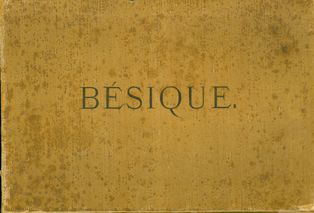 |
It was quite an eventful month with ups and downs, especially for
Miriam. We'll forget the downs, but one of the ups definitely was celebrating her
60th birthday. We had a party for friends here. |
|
May 2015
 |
It was quite an eventful month with ups and downs, especially for
Miriam. We'll forget the downs, but one of the ups definitely was celebrating her
60th birthday. We had a party for friends here. |
|
As said, this month our deck didn't come from Ebay or any other spot on the internet. Joop visited an outdoor flea market and a big, special bric-a-brac market without any luck at all. But he also visited a fellow collector with a specialization in the Dutch Speelkaartenfabriek Nederland. He had hoped that this collector would have sorted out some more patterns and had found irregularities that would be worth mentioning in the special SN "room" in our virtual Dutch playing cards museum (www.speelkaartenmuseum.nl). While discussing cards Joop's eye was caught by a large "bésique" box on one of the tables. Of course he could take a look and as it was for sale, it didn't take long before a price was agreed and Joop brought it home. The box held 4 decks of 32 cards each. The pattern looked familiar, but the most interesting part - and reason to buy the set- was that 2 of the decks were still in their original wrapper and the name on it pointed to a Dutch publication.
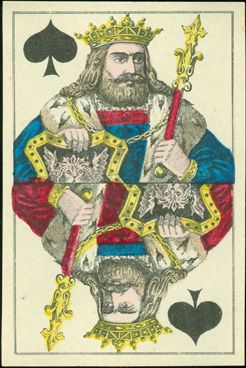 |
|
|
|
The pattern can be found in the I.P.C.S. pattern sheets as XP5/17 (sheet 77), but in a later version from around 1894, which was produced by Frommann & Morian from Darmstadt, Germany. Until now we too had always dated this pattern as c1890, but that was also based on the F&M version. We usually don't use the I.P.C.S. number to describe these kinds of patterns, with the "veiled" queens, but describe them as "obsolete". They must have been popular in the last quarter of the 19th century, but are too old-fashioned for the 20th century. You'll find a comparison between this deck and the F&M version here below. |
||
|
|
|
 |
The aces are plain and -like the other pips- have no number.
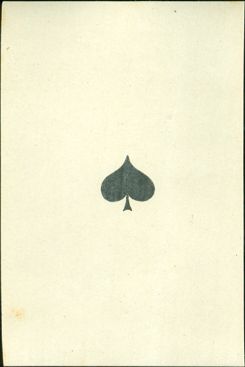
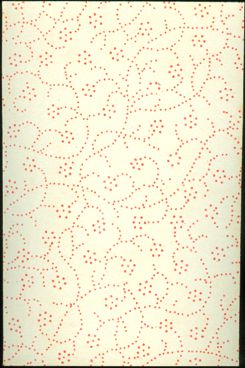
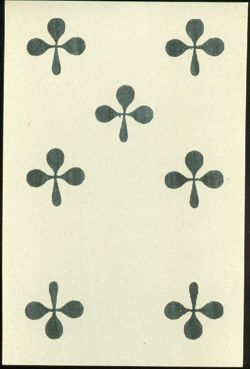
This kind of back design can be found in other antique decks too, by different makers and from different countries.
|
|
|
|
|
|
|
|
The name M.
Westerman & Zoon is printed on the original wrapper, the besique counters
and the leaflet with the rules for besique. Marten Westerman was a poet and
actor, who ran a bookshop to sustain in his living since around 1815. He had 3
sons, of which one died in the Belgian uprise. The business was continued as M.
Westerman & Zoon since 1830, when Gerardus F. Westerman was appointed
co-owner. By that time the bookshop had moved from Kalverstraat 198 to Kalverstraat 95. Gerardus Westerman stepped out in 1858, a few years after his
father had died, and became one of the founders of Artis Natura Magistra, the
zoological society that runs the famous Amsterdam zoo, commonly known as Artis.
It's not clear if there was still a Westerman responsible for the M. Westerman
& Zoon bookshop after 1858, but it was continued until 1878. By that time
A.J.G. Verster had bought the building on Kalverstraat 95 and the annexing
building. He had a new front build, which connected number 95 and 97. A.J.G.
Verster was acquainted with Joseph Perry from London and in a joint venture the
first Perry & Co department store in the Netherlands was opened there in 1888.
Between 1878 and February 2, 1888 a bookshop was kept by Albracht & Co. on
Kalverstraat 95. They had probably taken over the stock, as -thanks to Lex
Rijnen- we now know that an identical besique rules leaflet as below exists with the name Albracht & Co. on it. It's possible
that wrappers and besique counters with the Albracht & Co. name on it also
exist,
but until now none have turned up.
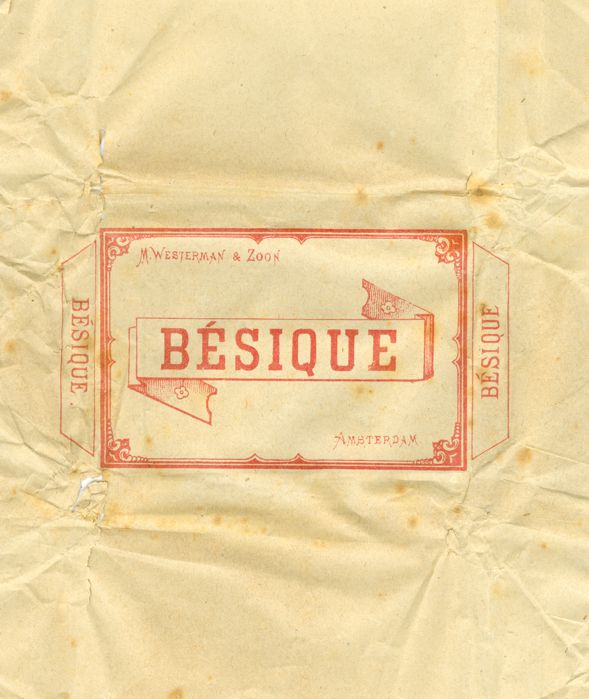
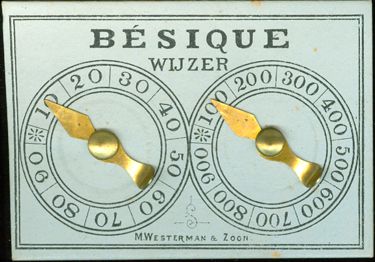 |
These are the less sophisticated ones, so without anything printed on the back. The luxury counters have a leather look and a score table on the backs. |
|
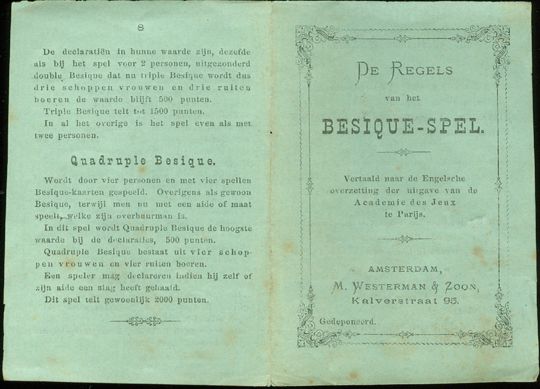

According to the leaflet with the rules of besique, the Dutch version was "translated from the English translation of the edition by the Academie des Jeux in Paris". In the Cartorama catalogue nr 56 Jean Darquenne offers a box with 3 besique decks, which was published by M. Westerman & Zoon, accompanied by a booklet that is dated October 1871. His decks had round, gilded corners and the pattern on the courts wasn't the same as in our deck, although generally it looked somewhat alike. In the above leaflet the publisher describes two editions of their besique game. A cheaper one, "Serie A (ordinary playing cards and besique counters)" and a more luxurious one, "Serie B (fine playing cards with gilded corners and elegant besique counters)". Both editions were probably published around the same time, which would date the decks as from 1871. Here below an ad in the Dutch newspaper "Algemeen Handelsblad" from January 19, 1872, in which our cheaper besique game is advertised. Jean's box probably was the 3 persons luxury version of fl. 4,00.
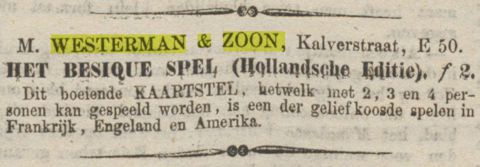
It took some
research, but at least the dating can be done quite accurately.
Leaves us with the question of maker and country.
Browsing through
our antique German decks, we came across a similar
deck. Here are a few
cards to illustrate the answer to those questions...


Even the back designs look alike...


The Jack of Clubs on the right has the clue that might answer the questions.

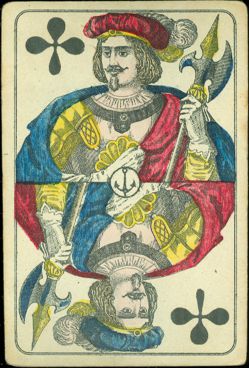
The anchor logo of the manufacturer in the center points to:
Frommann & Morian from Darmstadt, Germany.
However,
Frommann & Morian wasn't founded until 1874. It was a cooperation between
Friedrich Frommann (1841-1905) and Friedrich Morian. The company of Frommann & Bünte,
founded in 1872, was the joint business of Anna Frommann (1844-1922) and her
husband Georg Bünte. Both
these Frommanns were children of Maximilian Frommann (1813-1866), who had founded a print shop
in Darmstadt in 1835. It took 6 to 8 years after his death before the above mentioned
companies emerged. It's not certain, but one may assume that Friedrich and Anna Frommann have continued the printshop of their father from 1866 until
1872, when they probably couldn't agree anymore on how to continue the business.
With all these dates available, the conclusion can be made that our "Deck
of the Month" was probably printed by Maximilan Frommann's printshop, while
still under management of his children. This could explain the absence of a logo. Frommann
& Bünte used a deer's head with horns as their logo, Frommann & Morian
had their anchor.
It's nice to find plausible answers for a change and not have to ask visitors for that. But..... any further info or comment is always welcome.